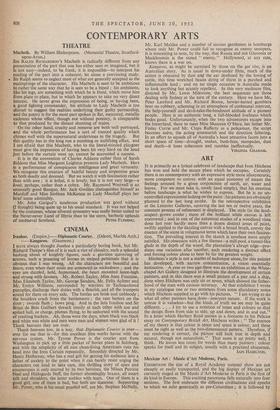Mexican Art : Mos& d 'Art Moderne, Paris.
EXHIBITIONS the size of a Royal Academy summer show are not cheaply or easily transported, and the big display of Mexican art currently staged at the MusCe d'Art Moderne in Paris is the first of its kind in Europe. This exciting panorama falls naturally into four sections. The first embraces the different civilisations and epochs to which we refer generically as pre-Columbian ; it is followed by
the. Colonial art of " the New Spain " through three centuries of Spanish domination ; the national school, that struggled slowly into being between the second decade of the nineteenth-century and the revolution of 1910, is shown in its most recent flowering ; lastly, and perhaps most surprising of all, is a section devoted to the exotic fantasies of contemporary popular " and folk art: The impact upon the spectator of this concentrated history is profound. It is the impact of an art sometimes different in degree from that of Western Europe, but more often different in kind. '- Through the whole exhibition runs a sense of public purpose. Mexican art has always tended towards the monumental, serving religious or social-political ends. It has the sturdy, robust, compact kind of vigour that comes with unself-consciousness. Whether using the beasts of the field and the birds of the air—notably the jaguar, the eagle and the serpent—as religious symbols, or expressing the aspirations of a toiling humanity in vast mural decorations, it has remained essentially realistic, though not always descriptive. Violence and magic are familiars ; death is a constant preoccupation. The human skull recurs again and again as a theme, from the days of the Aztecs to the sugar " calaveros " of today. All the arts of the pre-Columbian civilisations—the sculpture, the architecture, the ceramics, the jewellery, the frescos—are linked by a certain unity of expression, springing in part from the undoubted unity that exists between Mexican landscape and architecture, architecture and sculpture. Mr. Fernando Gamboa, in his preface to the catalogue, touches upon the connections between the hard top light of the southern sun and the bas-reliefs of the Mayas ; between the fantastic foliage of the shores of the Gulf of Mexico and " baroque " Tajfn sculpture ; between the geometric forms of the mountains and valleys of the central plateau and the palaces and temples of Teotihuacan. The compact economy of pre-Columbian statements—their expressive simplicity and exceptional respect for the medium—have provided a major source of inspiration to con- temporary sculptors (for example Henry Moore), so that much in this exhibition now appears as an astonishing anticipation. The simplicity disappeared, if not the monumentality, when the colonial art exploded into exuberant grandiosity in the eighteenth century. The centre-piece of this period is a golden retable—the smallest of ten, but still considerable in size—from the old convent of Tepotzotlan, an astonishing mass of encrusted gilt and polychrome sculpture. It returned in the next century with the naive charm of the provincial painters, Estrada, Bustos and others whose names have been lost. Posada (born in 1852, died in 1913) appears as the essen- tial link with contemporary painting. This master engraver, as remarkable for the fluency and economy of his technique as for his bitter irony and fantasy, has all the vigour of popular art which characterises the immense mural designs of modern Mexico. For the most part these can only be suggested by photograph and one or two movable examples, but the four major figures of contemporary Mexican painting—Orozco, Rivera, Siqueiros and Tamayo—are shown in strength. The school as a whole is distinguished more for its vigour than its subtlety, its literary content than its plastic inven- tion, but Rufino Tamayo, who is more concerned with pure painting than his propagandist colleagues, suggests something of the rich and sombre mysteries of pre-Columbian art. Then, at the end, the exhibition turns into bazaar and fair-ground and feast-day. Sorcery, the devil and death recur in the enormous bamboo and paper " judas " effigies, brightly coloured and hung with fireworks for burning ' • in the black-and-white paper models of engaged couples with skulls for heads ; and in the " calaveros," or sugar skulls, a few inches across and decorated with mottoes and flowers. The effect is like a shower of rockets after a solemn pageant.
M. H. MIDDLETON.



















































 Previous page
Previous page